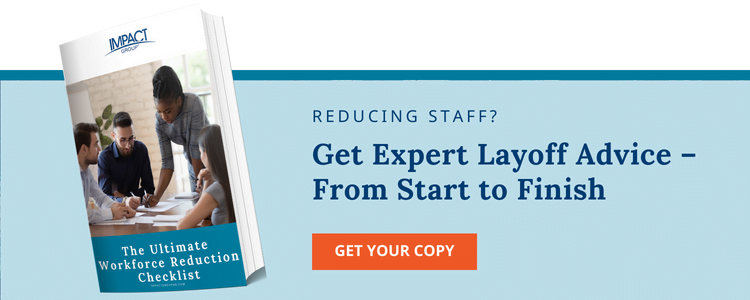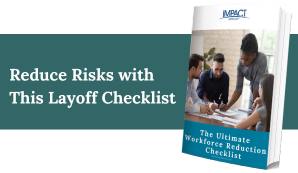In today’s economy, HR leaders must know how to lay off employees with compassion and professionalism.
Layoff talk has been in the news for years now. From January through April of 2023, job cuts increased 322% from the same period a year earlier. This is the highest January-April job cut total since 2020, according to Trading Economics.* You are not alone in researching how to lay off employees.
If it’s the first time you’ve prepared for layoffs, you will dread it. If you’ve done this before, you will dread it no less. Layoffs are something you never get comfortable with. And they can be especially brutal when your team works remote and these conversations will take place via phone and video.
How to Lay Off Employees with Compassion
At IMPACT Group, our team of career transition experts specialize in helping people move forward successfully. We work very closely with employers who want to manage these career transitions with care and concern for the exiting employees. We coach managers and leaders on how to lay off employees in a compassionate and caring way while delivering the notification.
While we have the experience and training, laying staff off is never a task we take lightly or one that gets to be “routine.” So for anyone who owns responsibility for layoff conversations, let’s review a few guiding principles. These will help you lead professional and compassionate layoffs:
- Be Prepared
- Be Timely
- Don’t Get a Signature
- Value the Person
- Remember It’s Not About You
- Don’t Tell the Story
- Acknowledge Outplacement – the Path Forward
- Visualize a Future Relationship
#1 Be Prepared
It takes time and thought to understand how to lay off employees. It’s usually done by HR professionals and sometimes with assistance from outplacement firms such as IMPACT Group. Your HR team should support you with:
- Talking Points – A brief “talk track” of what to say to the laid off employee, including the reason for the layoff or job elimination. (We don’t recommend you memorize a formal script, but read and say these talking points out loud.)
- Timing & Details – Know the employee’s official “last day” and what unused PTO the person will be paid for. Even an employee who may have anticipated the possibility of termination will most likely be ill prepared for the news. Show compassion for someone who is caught off guard by providing the facts in writing. Paperwork should include a written notification of termination and an FAQ that anticipates questions. (These might be about health insurance, unemployment eligibility, equipment such as cell phones and laptops, for example.)
- Legal Documents – All documents should be reviewed to ensure you are in compliance with all employment laws, including OWBPA and WARN. Sometimes states tack on additional provisions to federal laws. Hand out only the documents HR has provided you. If you are in HR, be sure to consult with your attorney.
To further prepare for delivering the layoff decision: Get a copy of IMPACT Group’s Notification Checklist.

#2 Be Timely
Your management team should coordinate timing so that the news gets dispersed quickly. Make sure it happens on the same day, and within a 1-4 hour timeframe if possible. That’s because news will travel fast. Everyone will check their calendar to see if they have any mysterious meetings scheduled without an agenda. And the stress circus will begin, with everyone watching the high wire acts. “Who is that up there about to fall? Am I next?” Block time in your schedule so you can deliver the news without delay.
HR should monitor activity and let you know when notification is complete. Once every laid off employee has been notified (on you team or across the company, as appropriate), immediately reach out to those whose jobs are not affected, so they can end the excruciating wait.
#3 Don’t Get a Signature on a Severance Agreement
If you are offering a severance agreement, have the document ready for the employee to take or download. But understand that now is NOT the time for the employee to review or sign the agreement. It is imperative that you do not do or say anything that the laid off employee might interpret as your strong desire for him to accept the severance offer. Severance agreements typically obligate employees to waive their right to take certain legal action, so it’s a decision that needs to be carefully considered and not rushed. (In legal terms, you do not want to be guilty of coercion.)
#4 Value the Person
Maybe this next part goes without saying as you discover how to lay off employees, but remember that this employee’s intrinsic value has nothing to do with his/her employment status.
Why bring this up? Some of us in management have been told we’re “less than great” at our soft skills. If we have to be the bearer of bad news, we may be tempted to rationalize as to why this laid off employee “brought this on himself” or “should have known better.” So just in case you feel the need to train yourself not to come across as robotic, unfeeling or even vindictive, take a second to think about this person in a favorable light. If you don’t know this employee at all, imagine how much he is adored by his wife, partner, parents, kids and colleagues.
Particularly if she is not your favorite employee, reflect on what you (or others) like about her. Maybe she has treated you poorly, acted unprofessionally, did a bad job, undermined your authority or is guilty of other wrong doings. It doesn’t matter at this moment. During a layoff notification conversation, your kindness comes through by being professional and prepared. If you think just a hint of “I knew this day would come” could creep into your voice, then take a minute to level set. In other words, let go of any perceived transgressions. We’re all human.
See also: Layoff Training Prepared Your Team to Lead through Difficulty
#5 Remember It’s Not About You
Sometimes a very kind laid off employee will remark, “Wow, I can see this is not easy for you either. Do you have a lot of people you have to lay off today? That must be really hard for you, too.”
This is not your cue to dive into a long description about how much you were dreading this day, or how you couldn’t sleep last night or anything akin to how hard it is for you. Just say something like, “Thanks, that’s kind of you to say.” But say no more about your anxieties!
Likewise, now isn’t the time to talk about a similar time in your life when you were laid off or between jobs. You may be tempted to mention these past experiences as you seek to empathize, but again, it’s not about you. The employee might not view the story of your hardship as an equitable comparison to hers, so no need to bring it up.
#6 The Next Expert Tip on How to Lay Off Employees? Don’t Tell the Story
Even while your mind is heavily focused on how to lay off employees, careful attention needs to be paid to your remaining staff as well. (Survivor syndrome is a good thing to research and understand.) Chances are some of your remaining colleagues will have sincere concern for the laid off employees or might just be curious. Either way, they may ask you to relate a summary of your conversation. “So you had to let Chris, Raj and Ellen go. How did they take it?” Don’t dish out any private details. An appropriate reply might be: “Everyone was very professional, even if disappointed. I really wish them the best.” Or, “They are such good people with great credentials. I’ll miss them.” Or “It was hard news to deliver and hard to hear. I feel for them.” “I’m glad they have the option to get outplacement coaching.”
If someone is having what might feel like the worst day of his life, he may not behave as himself and may react with bursts of emotion. Describing such displays shows a true lack of empathy. Remember that the departing employees will likely be in contact with their former colleagues and friends from work. You definitely don’t want any disparaging or insensitive comments getting back to the laid off employee. If something unexpected or unusual happened, bring up any concerns with HR or your direct manager.
When possible, it’s advisable to have two people deliver the news (a direct manager, HR partner or outplacement consultant). That way, if someone says or does something that is threatening or potentially dangerous, two people are present to witness the behavior and can help assess the situation.
#7 Acknowledge Outplacement – the Path Forward
If outplacement services are being offered to laid off employees, mention this benefit and encourage the employee to have a conversation with the outplacement firm. This will help them make a decision about it. It is not your job to coach the employee into an outplacement program. However, a short mention is worth it, since many businesspeople have either a dated view or very little understanding of outplacement. Whether the employee intends to get a new job, retire or start a business – outplacement coaching is a great value – to the employer and employee.
The caliber of coaches at IMPACT Group would likely impress your employee, who probably has never had an opportunity to have one-on-one sessions with someone that has coached hundreds of executives and professionals through starting a business, transitioning to a new career, relocating for a job or retiring.
In addition to years of business experience, IMPACT Group coaches’ credentials include two or more of the following: hold at least one coaching certification, teach at the university level, sit on corporate or non-profit boards, have advanced degrees from prestigious universities, had past careers at Fortune 1000 companies, have owned their own business or have lived and worked in multiple global locations.
Your HR team may want you to request the employee’s current personal email address and cell number. This enables you to communicate easily after the employee’s corporate email address is inaccessible. This is critical too so that your outplacement firm has necessary contact data.
#8 Visualize a Future Relationship
Recognize that things change, and this day may not be the end of your relationship. “Boomerang rehires” can resurface in your life. You may be working with this colleague again – at your current company or elsewhere. This employee may go to work for a customer organization. In turn, they may end up having a large degree of influence in decisions affecting you and your company in the future. This employee may return as a consultant. You may work for her someday. Or you may meet again outside work. (She could marry your nephew, and you’ll see each other every holiday season!) As far-fetched as any of these scenarios may sound, it’s true that throughout one’s career, we’ll encounter many of our past colleagues again – and often in dissimilar roles!
If the employee asks you to provide a recommendation, ask the employee to email or text you with some thoughts about what he wants you to say. (It’s helpful if you know how he intends to market himself – or at least how he sees his strengths.) You don’t want to give someone a false reference, but you can at least try to search for something positive. Offer to link up with the person on LinkedIn, if you aren’t already. If you feel it’s appropriate and will align with your company’s culture and policies, offer to provide a recommendation via LinkedIn.
You are a strong, caring leader for researching how to lay off employees.
It shows you want to get this right for your exiting employees and your company.
Prepare yourself with more tools. Download your guide to Employee Layoffs: 17 Best Practices now.

*United States Challenger Job Cuts, Trading Economics, 2023










